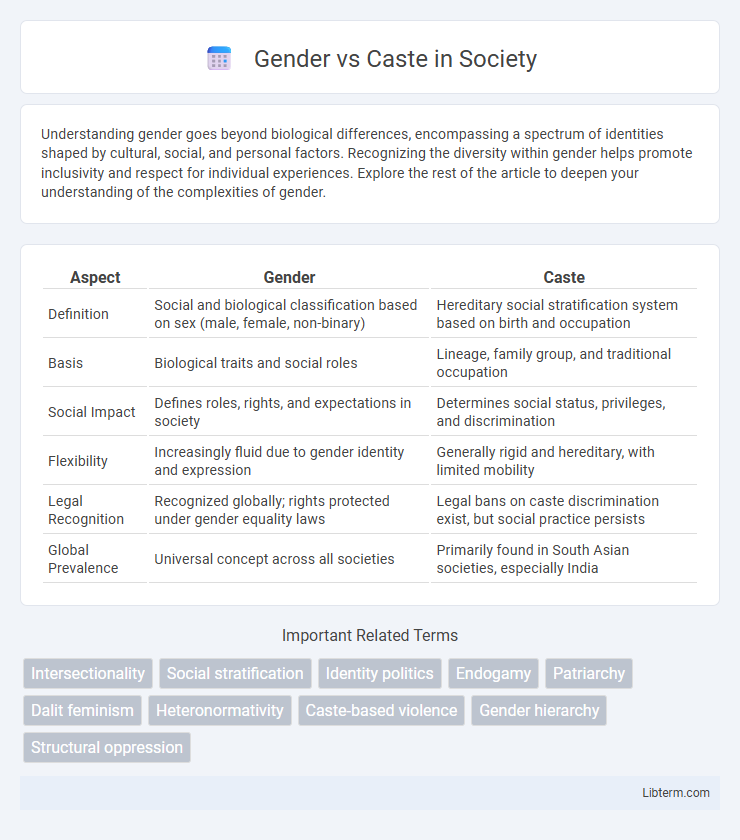Understanding gender goes beyond biological differences, encompassing a spectrum of identities shaped by cultural, social, and personal factors. Recognizing the diversity within gender helps promote inclusivity and respect for individual experiences. Explore the rest of the article to deepen your understanding of the complexities of gender.
Table of Comparison
| Aspect | Gender | Caste |
|---|---|---|
| Definition | Social and biological classification based on sex (male, female, non-binary) | Hereditary social stratification system based on birth and occupation |
| Basis | Biological traits and social roles | Lineage, family group, and traditional occupation |
| Social Impact | Defines roles, rights, and expectations in society | Determines social status, privileges, and discrimination |
| Flexibility | Increasingly fluid due to gender identity and expression | Generally rigid and hereditary, with limited mobility |
| Legal Recognition | Recognized globally; rights protected under gender equality laws | Legal bans on caste discrimination exist, but social practice persists |
| Global Prevalence | Universal concept across all societies | Primarily found in South Asian societies, especially India |
Understanding Gender and Caste: Definitions and Context
Gender refers to the social and cultural roles, behaviors, and identities associated with being male, female, or non-binary, distinct from biological sex. Caste is a hereditary social stratification system primarily found in South Asia, defining hierarchical groups based on birth and occupation, deeply influencing social status and access to resources. Understanding these concepts requires recognizing gender as a fluid spectrum influenced by cultural norms, while caste is a rigid, inherited classification shaping societal interactions and power dynamics.
Historical Origins of Gender and Caste Inequalities
Historical origins of gender inequalities trace back to patriarchal societies where social roles were rigidly assigned based on biological sex, limiting women's access to power, property, and education. Caste inequalities originated in ancient India through a hierarchical system codified in religious texts like the Manusmriti, which entrenched social stratification and occupational restrictions tied to birth. Both systems institutionalized exclusion and discrimination, shaping long-lasting socio-economic divisions globally and within specific cultural contexts.
Social Structures: How Gender and Caste Shape Identity
Gender and caste are fundamental social structures that profoundly shape individual identity by dictating roles, privileges, and social expectations within a community. Caste often determines access to resources and social status, while gender influences personal agency and societal participation, creating layered hierarchies. The intersection of gender and caste produces complex forms of discrimination and identity formation, impacting social mobility and cultural belonging.
Intersectionality: When Gender Meets Caste
Intersectionality reveals how gender and caste intertwine to shape unique experiences of discrimination and privilege, particularly in South Asian societies where caste hierarchies are deeply entrenched. Women from lower castes face compounded oppression through both patriarchal norms and caste-based marginalization, influencing access to education, employment, and social mobility. Understanding this intersection is crucial for developing inclusive policies that address the multifaceted barriers affecting marginalized communities.
Legal Frameworks Addressing Gender and Caste Discrimination
Legal frameworks addressing gender and caste discrimination include the Indian Constitution, which guarantees equality and prohibits discrimination under Articles 14, 15, and 17. The Protection of Civil Rights Act, 1955, and the Scheduled Castes and Scheduled Tribes (Prevention of Atrocities) Act, 1989, specifically target caste-based discrimination and violence. For gender discrimination, laws such as the Equal Remuneration Act, 1976, and the Sexual Harassment of Women at Workplace (Prevention, Prohibition and Redressal) Act, 2013, provide crucial protections and promote gender equality.
Economic Disparities: Gender vs Caste Analysis
Economic disparities reveal significant differences between gender and caste, with caste-based discrimination often resulting in entrenched poverty and limited access to resources among marginalized communities. Women across all castes face wage gaps and employment barriers, but women from lower castes encounter compounded disadvantages due to intersecting caste and gender biases. Data from the National Sample Survey highlight that lower-caste women earn substantially less than upper-caste men and women, underscoring the necessity of nuanced policies targeting both caste and gender inequalities in economic opportunities.
Education and Access: Bridging Gender and Caste Gaps
Disparities in education access remain stark along both gender and caste lines, with Scheduled Castes and Scheduled Tribes facing higher dropout rates and lower enrollment, especially among girls. Social norms and economic barriers limit educational opportunities, perpetuating intergenerational cycles of inequality. Targeted policies promoting inclusive schooling and scholarship programs are crucial to bridge these gaps and enable equitable access for marginalized gender and caste groups.
Representation in Leadership: Gender and Caste Perspectives
Representation in leadership roles continues to reflect significant disparities across both gender and caste lines, with women and marginalized caste groups notably underrepresented in political, corporate, and social leadership positions. Data from various countries reveal that women occupy less than 25% of parliamentary seats globally, while caste-based discrimination limits leadership access for lower caste individuals, especially in South Asia where affirmative policies remain unevenly implemented. Efforts to increase representation emphasize intersectional approaches that address both gender inequalities and caste biases to foster inclusive leadership structures.
Cultural Narratives Reinforcing Gender and Caste Bias
Cultural narratives in India often intertwine gender and caste, reinforcing patriarchal and hierarchical structures through myths, religious texts, and folklore that legitimize male dominance and caste superiority. These stories perpetuate stereotypes by glorifying upper-caste male hegemony while marginalizing women and lower-caste communities, sustaining systemic discrimination. Educational content and media representations continue to propagate these biases, making it challenging to dismantle deep-rooted social inequalities.
Pathways Toward Equality: Addressing Gender and Caste Barriers
Addressing gender and caste barriers requires targeted policies that promote equal access to education, employment, and political representation for marginalized groups. Intersectional approaches that consider both gender and caste dynamics enhance social inclusion and economic empowerment. Community engagement and legal reforms are critical pathways toward dismantling systemic discrimination and achieving lasting equality.
Gender Infographic

 libterm.com
libterm.com